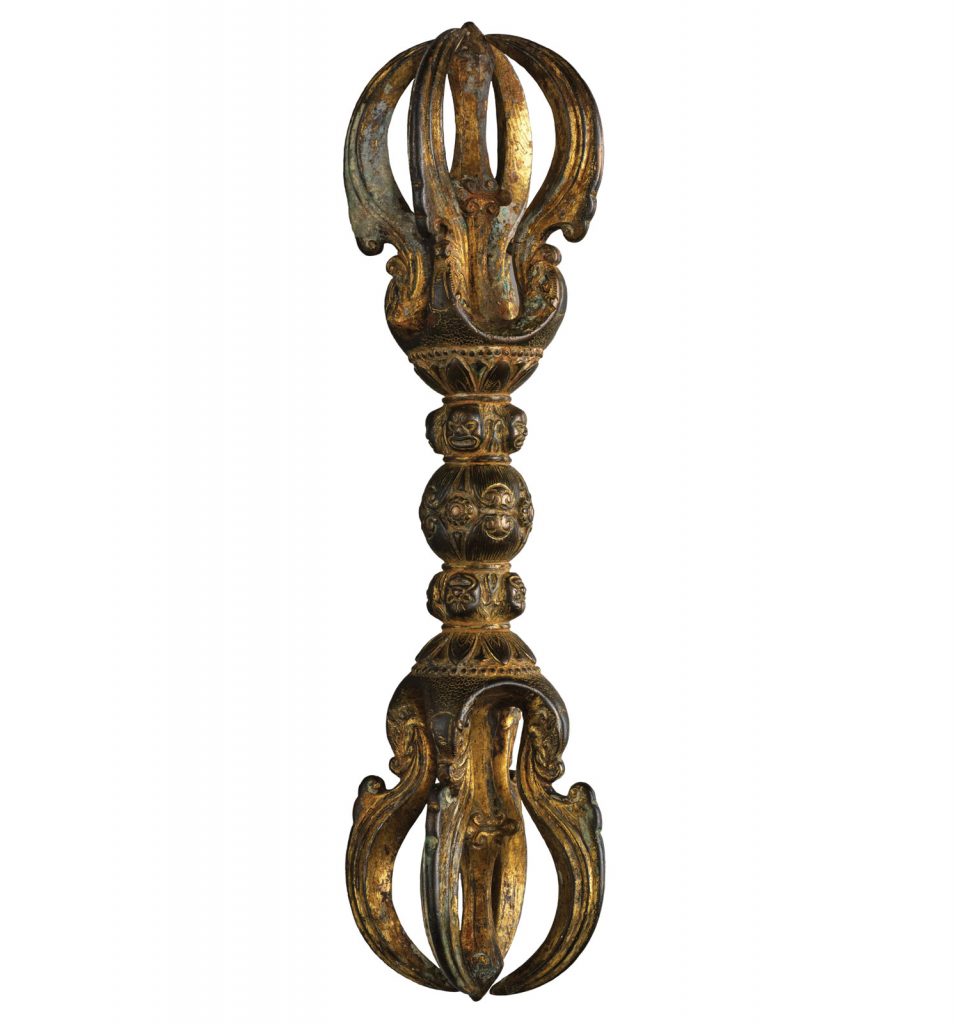The vajra (Skt., “lightning bolt”; Tib., dorje) plays an important role in Buddhist art and ritual and is particularly associated with Vajrayana Buddhism, the vehicle (yana) of the vajra, representing indestructable power. Several early Mahayana sutras speak of the vajra samadhi, the final meditative absorption a bodhisattva engages in before entering full buddhahood. The place of Shakyamuni Buddha’s enlightenment is known as the vajra asana (vajrasana), a term that refers both to the actual site (marked by a stone slab) and, by extension, to Bodh Gaya. The posture of the meditating Buddha is also called the vajrasana, the posture known to yoga practitioners today.
Most often the vajra appears as a weapon, like the lightning bolt of the northern European god Thor or the southern European god Zeus; it is especially associated with the Indian Vedic god Indra, king of the heavens, who appears in early Buddhist tales as Shakra (“mighty”). The vajra as weapon is wielded like a club by figures such as the wrathful deity Vajrapani in order to subjugate an external or internal obstacle and thus is simultaneously a tool of compassion and skillful means leading to the indestructible state of enlightenment.
In Vajrayana Buddhism the vajra, bell, and mala (prayer beads) are the three most important ritual objects. The vajra and bell are not typically part of ordinary daily practice, but for group practice or a major ritual they are used together, sometimes with the addition of a drum. The vajra is also an object of visualization: in the practice of deity meditation, the foundational meditation of Vajrayana Buddhism, the practitioner at one stage is commonly asked to visualize the mind becoming or appearing as a vajra.
The physical form of a vajra is determined by the specific ritual purpose it will serve. Often its basic design is that of a short central section with prongs on either side that curve inward to create a spherical enclosure. In Japanese traditions such as Shingon or Shugendo a single-pronged vajra is generally used for protection from the snakelike beings known as nagas.
Most commonly seen is the five-pronged vajra, which can represent the five celestial Buddhas, the five Buddha wisdoms, and so on. This form is favored by the “new schools” of Tibetan Buddhism (Kadam, Sakya, Kagyu, Gelug, and Jonang), whereas the “old school”—the Nyingma—often prefers a nine-pronged vajra, which has various meanings including a reference to categories of Nyingma teachings.
The appearance of the vajra also varies from region to region. In a provincial area, a vajra may be shaped distinctively simply because its creator is not familiar with the traditional form. Vajras coming out of India and Nepal at the end of the first millennium CE are usually simple in design; more ornate examples appear in China during the Yuan dynasty of the early 14th century when the ruling Mongolian emperor had elaborate vajras and bells created as gifts for Mongolian teachers, and again during the Ming dynasty when the Yongle emperor had gifts made for the visiting Karmapa of the Kagyu school.
Thank you for subscribing to Tricycle! As a nonprofit, we depend on readers like you to keep Buddhist teachings and practices widely available.
